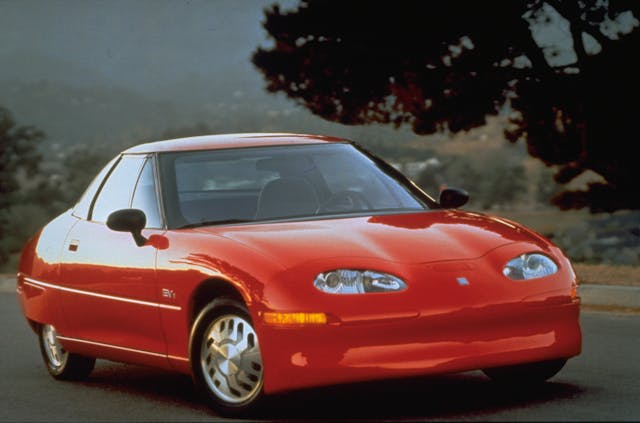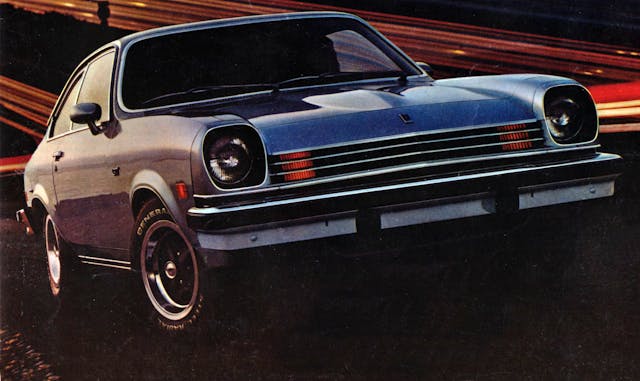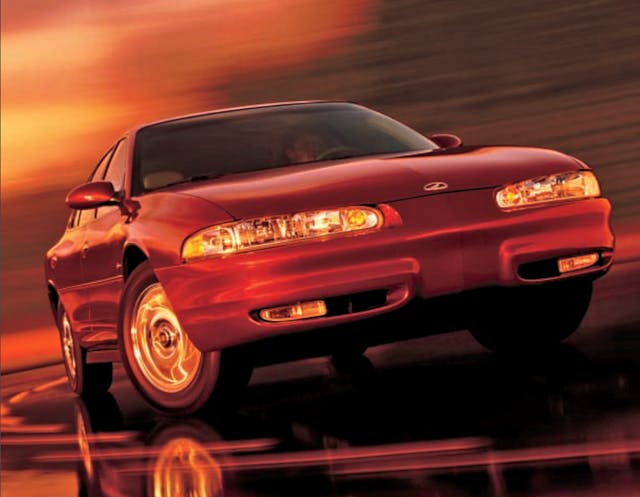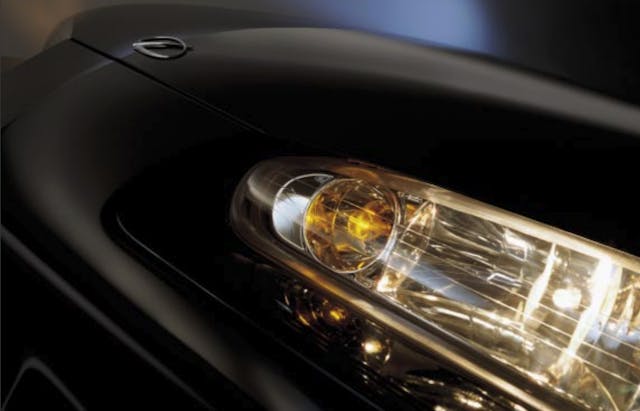Media | Articles
9 tragically flawed GM vehicles whose heroic fixes came too late
Decades upon decades passed when General Motors could do no wrong, and the products rolling off its assembly line were proof positive of its business model’s supremacy. But nobody’s perfect, and mistakes had to be addressed to meet stockholder’s expectations. GM’s design and engineering teams made some great cars with serious potential that were packed with tragic flaws—and received heroic fixes that came right before their curtain calls. It’s all rather tragic, so here are nine examples to prove the point.
1993 Cadillac Allanté (Northstar)

You gotta give General Motors credit, because when it aims for the stars, it grabs a firehose full of ideas and shoots skyward. Take a shortened E-body coupe and turn it into a bespoke V-body, then deliver finished shells from Italy’s Pininfarina to Hamtramck via a convoy of Boeing 747s known as the “Air Bridge.” One of the biggest keys to the Allanté’s failure was the drivetrain layout (front-wheel drive does not a Mercedes SL competitor make) and the mediocre performance of Cadillac’s High Technology V-8 engines.
The lack of power was finally addressed in 1993, the Allanté’s final year, by the rocket-like thrust of Cadillac’s all-new Northstar V-8. The added grunt was competitive, but 1993 also included a heavily revised rear suspension, active dampers, and revised power-steering. As we previously mentioned, the 1993 Allanté was “finally, the internationally competitive luxury roadster its creators had envisioned … albeit six years too late.”
1988 Pontiac Fiero

One of the big problems with the Pontiac Fiero, aside from the engine fires of the early models, was the promise of sporty performance, which wasn’t realized until the last year of production. As we previously mentioned, cost-cutting sealed the Fiero’s fate well before 1988. There was simply too much parts-bin engineering: The compact X-body (Citation) front suspension was flipped 180 degrees and dropped in the back, while the front suspension was lifted from the T-body subcompact (Chevette). It’s a shame that in the Fiero’s final year the necessary suspension upgrades (new front control arms, knuckles, and an all-new tri-link rear suspension, plus a wider front track and, on WS6 models, staggered wheels) and improved brakes (four wheel vented discs) couldn’t alter the course of history. These bits were precisely what Pontiac engineers intended for the Fiero from the get-go. At least we got one year of mid-engine Pontiac Excitement.
2020 Cadillac CT6-V (Blackwing)

Hate to say it, but the Cadillac CT6 is not unlike the Cimarron before it. That’s because the last examples of Cadillac’s J-body experiment indeed improved when a 2.8-liter V-6 and five-speed manual transmission were standard equipment. Similarly, the CT6 never set the world on fire, because a flagship luxury sedan needs more swagger under the hood than a turbocharged four-cylinder could ever provide. (Yes, the CT6’s standard engine was 0.8 liters smaller than what’s on tap for a 1987 Cimarron.)
Marketplace
Buy and sell classics with confidence
The CT6 didn’t receive a proper V-8 until the 2020 CT6-V hit the scene with the similarly star-crossed Blackwing motor. Because there is still a market for upper-crust luxury sedans (think Mercedes S-Class), the CT6 deserved an optional V-8 from the start. What happened when the CT6 got it all? Both the engine and the car unceremoniously met their maker.
1917–18 Chevrolet Series D

The Series D was truly a car ahead of its time, sporting a standard overhead-valve V-8 engine that came a full 38 years before the famous small-block Chevrolet V-8. A gentleman named A.T. Stuart designed a surprisingly lightweight chassis and a rear suspension with quarter-elliptic rear leaf springs mounted in a rather radical cantilever fashion. All of which should have meant a longer production run for the Series D, so what happened? General Motors happened. It’s a safe bet that the 1917 integration of Chevrolet into General Motors ensured the premium Chevrolet V-8 could never be a threat to offerings from Oldsmobile and Buick.
General Motors EV1 (NiMH upgrade)

This one is a no-brainer: Have a look at the photo that comes with the Wikipedia definition of compliance car. The EV1 was ahead of its time and yet destined for failure. We’ve discussed the truth about this car previously, but the fact remains: The EV1 only improved toward the end, when the second generation received nickel-metal hydride (NiMH) batteries. While NiMH aren’t nearly as good as the li-ion batteries that made Tesla famous, the EV1 proves that General Motors was dead-serious about electric propulsion. And it doubled down on its efforts by improving the EV1 … before they crushed (almost) all of them.
1929–31 Viking

Based on one of GM’s first shared platforms (the ubiquitous 1926–96 GM B-platform), the Viking by Oldsmobile was a short-lived experiment in premium branding for an established automaker. While this notion was successful for Oakland (i.e. Pontiac) it didn’t work out here, or at Buick (with Marquette), or at Cadillac (with LaSalle). Well, perhaps it worked a little too well for Oakland. No matter, Viking was “built to meet growing public demand for an eight-cylinder car of General Motors quality at medium price.” Talk about irony: The Series D mentioned above was doing the same for Chevrolet a little over a decade before. GM knows market segmentation can only take it so far, but market research in the Herbert Hoover era was probably lacking a bit.
2006 Chevrolet SSR (LS2)

Chevrolet’s Super Sport Roadster was a truck with a folding hardtop, styled to be a hot take on the “Advance Design” pickups from 1947. The look was great, but it rested atop a revised GMT-360 platform (shared with the Trailblazer SUV) with a workhorse 5.3-liter V-8 (300 horsepower) that ensured the SSR didn’t perform as well as some hoped.
The combination of brilliant style atop mundane underpinnings is not unlike the Pontiac Fiero’s tragic tale, as looks weren’t enough to keep questions about SSR’s longevity at bay. The asking price was steep and sales were disappointing, but the penultimate year (2005) saw the introduction of the LS2 small block V-8 (390 horsepower) and an optional six-speed manual transmission. Could this be the reincarnation of the El Camino SS? Unfortunately not, as only 826 units were sold in 2006, even with a modest power bump (+5 for autoboxes and +10 for manuals). Perhaps the future coulda been brighter if the combination of LS2 LS6 and manual transmission was available from the get-go … or perhaps power was never the SSR’s problem.
1976–77 Chevrolet Vega

I come not to bury the Chevrolet Vega, but to praise it. The early models certainly had their problems, but like most American cars in the 1970s, a cornucopia of running changes happened behind the scenes and never got the attention they deserved. This isn’t just about big bumpers and catalytic converters, as there were presumably 264 changes in 1975 and 300 changes the year after. Our nation’s Bicentennial anniversary ushered in an honest-to-goodness five-speed manual transmission, corrosion-fighting improvements, cooling upgrades, revised chassis, larger brakes, and an upgraded rear suspension. The Vega’s final year (1977) was cleaner thanks to a revised secondary air-injection system, and the insides looked more upscale with color keyed steering wheels, steering columns, and a color-matched full console. While the Vega lived a long life (and spawned the sporty Monza/Skyhawk/Starfire/Sunbird) it’s safe to say that many of the best Vegas ever made were the last ones.
2002 Oldsmobile Intrigue

I’ll let you in on a little secret: General Motors’ long running W-body platform is rather underrated, and the best of the breed came from Oldsmobile. No other W-body has the clean, modern styling and sweated the details quite like the Intrigue. No really: I mean, just look real close at that nose!

While there was nothing particularly wrong with the Intrigue, unlike other Oldsmobiles that benefited from performance upgrades (think supercharged 3800 engines), the Intrigue died three years before the wicked 5.3-liter V-8 engine (LS4) was shoehorned into the W-body Pontiac Grand Prix GXP. If only the Intrigue GLS could have the LS4 V8 tearing up the streets, violently torque-steering its owners off the road with just a touch of the traction control button and a punch to the gas pedal. Iron fist, meet velvet glove: If only the Oldsmobile division survived long enough to make this happen!














GM is like a procrastinating child…..
Delaying and waiting to make the right decisions until it is too late.
So many cool vehicles left to die because of GM’s inability to do the right thing from the get-go.
Have everyone forgotten about turning a chevy 350 into a diesel?
That was an Olds based 350 Conversion not Chevy.
I am a Ford guy but even I was disappointed when the Fiero was discontinued just as it was starting to get its wings! The last two years were one of the nicest looking cars ever made in my opinion. An older brother of a guy I graduated high school with in Minnesota back in 1984 was on the Fiero design team. I remember how proud he was of his big brother. Of course that was back when we had a distinct American auto industry when more risks could be taken. I think GM made a mistake not to at least go a few more years on the Fiero, if anything just for the credibility which can translate to sales of other same brand vehicles.
GM wasn’t advertising the Fiero in the last year. Sales dwindled as a consequence.
It was a great design, without question, but in hindsight sales of two seat cars haven’t been stellar. The Miata and Saturn didn’t sell well. GM wants volume and it’s car for that is the corvette
I had a 1983 Camaro with the “iron horse” fuel-injected 2.5 liter four, which was the initial engine in the first Fiero. All it needed was a turbo charger and much better quality control. Fact is those cars from the early to mid-80s were just not very well built, plagued with major problems. The 4-speed transmission, there was no five speed offered on those cars, failed with just 250 miles on the odometer. The dealer replaced it with a transmission from another car in stock. I sold it within six months and have never bought another GM vehicle. Besides the car was a dog. I’ve stuck with Toyotas for a few years now.
I was born in 1966
So in the 80s I got to drive all offerings.
I even bought a cheap used chevette in 1989 to save gas on 120 mile daily commute that my 71 Firebird was being used for . But after a few weeks I went back to the Firebird .
And I had already owned a 76 and a 1980 Toyota Celica , so a chevette was just no comparison .
My brother bought a 88 Fiero in 1991 , and still owns it . And with the addition of a 4.9 Cadillac V8 is the car it should always have been , and GM finally made a V8 Fiero , it’s called the new corvette !
Y’all forgot about the V-8-6-4 garbage in the Cadillac, which didn’t work and still doesn’t work now that they have brought it back in the LS engines. When it fails it destroys the entire engine .
GM is famous for spending tens of millions redesigning cars and then killing them soon after .
They never put a powerful engine in the Fiero because it would have outperformed the corvette .
And the Fiero was doomed from the price increases , when it was first introduced in 84 or 85 it was $7,000
Then in four short years , by 1988, the price had doubled to $14k
Which was the same or slightly more than a new well optioned V8 Trans Am sitting right next to it in the show room .
And even the 94-96 impala SS , for the 96 model they redesigned the interior for bucket seats and a floor shifter , knowing that it was going to be the last year of the car .
GM could have made tons of money with different body kits for the Fiero like all the aftermarket was supplying .
Jeep is leaving lots of money on the table by not doing different front ends on the wrangler to cash in on the retro themes
That was what killed the Fiero. The car was getting more power and was going to under cut the Corvette by neat $10,000. The Vette team was in fear with their own dropping C4 sales of not getting the C5 approved.
Oddly in the end the C5 was canceled and they ignored GM and finished the car and it was good enough to get the business case approved for production.
GM failed to manage their divisions and they hurt each other vs complimenting each other.
The Fiero could have been the entry model leading to the Corvette.
The Fiero actually complimented the Trans Am as when I bought mine the insurance was half on a GT vs a Trans Am.
The 864 Cadillac was an example of GM pushing tech before it was ready. The LS was just a failure to spend the money to do it right.
It is fixed today and is on everything from 4 calibers to v8. None are having issues any longer.
Fiero yes. Nice to see a Caddy without a chevy engine. Didn’t know that about the early chevy. Shame on you for comparing its looks to the beautiful El Camino ,its even uglier than the PT Cruiser.
I’d volunteer 4 more: the 2009 Saab 9-5 Epsilon body, the HUMMER H3 pickup, the Pontiac Solstice Coupe and the Saturn (Opel H-series) Astra XR Coupe. all were highly evolved versions of their respective breeds, lives tragically cut short by the GM bankruptcy of 2009- the Solstice Coupe actually announced weeks within the news of its division being dropped. The H3 truck brings a premium in the secondary market. The Astra was a global platform built in Belgium and marketed as an Opel, Vauxhall, Chevrolet or, in the US, a Saturn; per-unit sales lost so much money that only about 10,000 made it here before the end of Saturn.
All can be said here was these were Lutz cars that just came too late.
Bob did a lot of good things but he arrived just too late to save them. It is amazing that he was able to do do much with so,little money.
Could you be the same Jon Albert of the Fiero ID design?
Over the last 40 to 50 years, GM has been the biggest example of a slowly failing car company. In 2009, instead of actually letting it fail, it was bailed out. Sooooo many stupid decisions.
Since then, seems like they haven’t learned how to do anything different except kiss government as*.
in 1980 olds had a v6 diesel in the cutlass i worked at the dealer, customers complained the fuel gauge didn’t work because the cars got 53 miles to the gallon. only saw a couple gm quickly got rid of those it made the rest of the fleet look bad. we all missed out on that one. and I’ve never heard of that one from anyone else in all these years.
While many like to diss GM they have gotten many things right.
They are not struggling financially like Ford and have not sold out twice like Chrysler.
Things are better. Perfect no but who is? Not Toyota.
I had a 1985 Cadillac back in the day with an 864 engine. Now there was a failure from the getgo.